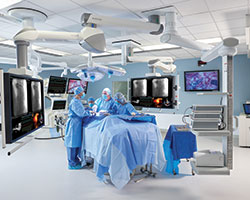Integrated Operating Rooms
What is an Integrated Operating Room?

Operating rooms (OR) have evolved tremendously with technological innovations delivering enhanced patient care in and out of the OR. Hospitals continue to design operation theatre rooms focusing on greater functionality and improved patient comfort. A concept that shapes OR design for hospital staff in the present and future is the integrated operating room also called a digital operating room.
OR Integration connects technology, information, and personnel throughout the hospital to create a purpose-built system that reduces the dependency on mobile equipment. With advanced audiovisual technology, such as multi-image touchscreen displays and real-time monitoring systems, staff within the OR have limitless access to patient information archives and resources. This establishes smarter interconnectivity between the outside world to improve clinical outcomes and lessen traffic moving in and out of the sterile operating environment.
Benefits of Integrated Operating Rooms

With an integrated OR, personnel have fewer reasons to leave the operating theatre due to direct connectivity with other hospital equipment and information systems through an interface with the OR. This connection means an integrated OR can be more quickly and easily prepared for each scheduled procedure. Additionally, direct access to high-resolution imaging equipment like X-ray, CT, MRI, and other diagnostic equipment means patients do not have to be moved during surgery when imaging is required. As a result, this creates the opportunity for more minimally invasive surgeries.
One of the most significant benefits of OR Integration extends beyond the operating room as OR Integration connects and supports teams, processes, and information to improve operative workflow. For example, OR Integration allows in-OR teams to share surgical videos and images with remote specialists for consultation, with classrooms of students for teaching applications, and real-time peer collaboration with another surgeon at a different location for procedure guidance. After a procedure, a clinician can easily show high-definition images of the procedure on a tablet during a post-operative consultation with the patient and family. Conveniently, OR Integration ensures that these images and videos are automatically associated with the patient record for accurate documentation of every procedure.
What is an operating room integration system?
Due to the emergence of advanced diagnostic and imaging technology, the operation theater has become increasingly congested and complex, with many OR devices and monitors.1 Besides booms, surgical tables, surgical lighting, and room lighting positioned throughout the OR, multiple surgical displays, communication system monitors, camera systems, recording devices, and medical printers quickly become associated with a modern OR.
An OR Integration System is designed to simplify and streamline the OR by consolidating data, access to video, and controls for all of these devices at a central command station. This allows the surgical staff to perform many tasks efficiently without moving around the OR. OR Integration also commonly involves suspending monitors and imaging modalities within the OR, removing trip hazards caused by cabling, and allowing for easy access and visibility to surgical video. The HexaVue™ IP Integration System connects the operating room with the sterile processing department (SPD) to track surgical instruments and their readiness for surgery. Connectivity through the sterile processing management asset tracking software helps to improve visibility and real-time communication to ensure synchronized operations between the OR and the SPD.
Explore our Operating Room Integration Systems
Benefits of Operating Room Integration Systems

The OR is a demanding environment that requires focus, efficiency, communication, and expertise. Without OR Integration, surgical teams must navigate the operating room to perform various tasks. These tasks include checking a computer for patient information, writing it on a whiteboard, moving to the wall to control OR lighting, stepping into the surgical field to display or change the video they view, and more. The movement and time required to complete these tasks slow a procedure down and can detract attention from where it is needed most: on the patient.
OR Integration Systems consolidate and organize all patient data for the surgical staff during a procedure, minimizing congestion and streamlining information across multiple platforms.1 Through OR Integration, the surgical staff has centralized access to the controls and information they need – to view patient information, control room or surgical lighting, display images during surgery, and more – all from a centralized control panel. OR Integration provides the OR Staff with increased productivity, safety, and efficiency to keep focus on delivering patient care.
Types of Operating Room Integration Systems
OR Integration technology is available in various systems and prices, supporting low-complexity operating rooms to high-volume, complex ORs. The simplest OR Integration Systems promote simple visualization of a few devices on a few displays within the OR. At the same time, more complex systems may automate video routing, image capture, and equipment control. OR Integration Systems are suited for high-complexity ORs that build on these capabilities, adding the ability to connect and control many devices, collaborate in real-time using videoconferencing or streaming, and support advanced visualization in 4K ultra-high definition.
Explore our High Definition and 4K Surgical Displays
Just as OR Integration Systems offer different features to support each Operating Room's needs, they also vary in size and design to support a variety of environments. From small box-style systems that can fit on the OR desktop to larger systems that fit inside the wall or outside the OR, OR Integration Systems take various forms depending on the needs of the Operating Room.
Planning an Integrated Operating Room
OR Integration should be centered around the hospital's current and future goals, such as increasing OR revenue, efficiency, safety, patient satisfaction, or educational initiatives. Such goals cascade to how the in-OR staff should perform their tasks and how OR Integration can support success. For example, a teaching institution may prioritize communication from the OR and require OR Integration to support communication and collaboration between integrated ORs and transmitting video and audio from these ORs to neighboring classrooms or conference rooms.
The OR Integration System's ease of use ensures that the investment supports a profitable, efficient OR. If an OR Integration System is complex, cluttered, confusing, or challenging to navigate, staff may stop using it or only use small portions of its functionality. A well-designed system is not one-size-fits-all but customized to its users' needs for the performance of their unique workflow and clinical tasks and positions equipment out of the way of OR traffic.
Planning for compatibility is also crucial when evaluating OR Integration products. The integration provides a technical infrastructure in the OR that allows different medical devices, cameras, music devices, environmental systems, and lighting to work together seamlessly and harmoniously. The Integrated OR often offers compatibility with current and future technologies, which enables the hospital to quickly introduce new devices, like endoscopes or imaging equipment, to existing integrated ORs.
Integrated Operating Room Design

The design of an Integrated OR reflects the types of procedures performed in the room, the medical devices used, where surgical video must be viewed, available space, and the need for durability. The integration vendor works closely with the hospital to design an OR that supports their unique demands and an efficient and safe OR.
OR Integration ideally allows the hospital to locate equipment in the OR. For example, cart-based devices can be placed on the wall and connected to the integration system to enable the clinical team to view the device's video throughout the OR. Similarly, endoscopic towers can be located on the equipment boom in the OR, keeping the floor and neighboring areas clear of associated cabling. Displays are often mounted within an Integrated OR, on walls or light arms instead of on rolling carts, to allow easy visibility of surgical video from anywhere in the OR.
When designing an Integrated OR, floor space is maximized to allow the staff to navigate the OR effectively and to accommodate the equipment needed for each case. The OR Integration System is selected and located to be least intrusive to the staff. Depending on hospital preference, it may be located on or under a desk, in the wall, or outside.
Regardless of the procedures performed, the OR is one of the most harsh and challenging environments for electronics and cabling—particularly those routinely handled and plugged/unplugged. Therefore, components of an OR Integration System are often designed to withstand the rigors of the operating room environment. This includes weathering, regular cleaning, rough handling, and impact. Some components most prone to damage, such as surgical displays and video cables within the surgical field, are reinforced to ensure longevity.
CHALLENGES OF DESIGNING AN INTEGRATED OPERATING ROOM
Today's integrated ORs demand connectivity to data, systems, and individuals beyond the OR. When planning for an integrated OR, the integration vendor and hospital must consider the bandwidth availability and network configuration requirements for a seamless exchange between the OR and remote locations. Signal transmission compatibility also significantly impacts whether both locations can share media files or videoconference in real time.
Compared to less-detailed images or videos, today's high-resolution media files are generally larger and require more data storage. To ensure that adequate storage is available, planning for an integrated OR includes defining media storage requirements. If desired, authorized OR staff may choose to access or share their media from their hospital PC or mobile device. If online access is not desired, staff may default to printing images or transporting media on a CD or USB drive.
Protecting a patient's information is paramount; thus, any images, videos, or data containing patient information must be protected. For example, when sharing a video from the OR during a teaching event, patient information and identifying features should be hidden from the student's view. The design of the OR integration system and the way it is deployed within the hospital's network infrastructure can help ensure information security.
References
1 https://www.ncbi.nlm.nih.gov/books/NBK133359/
 United States
United States
 Canada (EN)
Canada (EN) Canada (FR)
Canada (FR) Deutschland
Deutschland Italia
Italia United Kingdom
United Kingdom Australia
Australia New Zealand
New Zealand Singapore
Singapore Brasil
Brasil México
México









